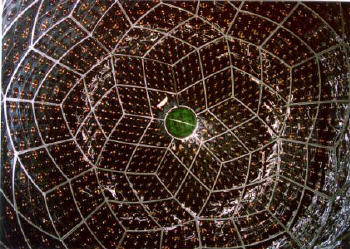One of the biggest mysteries lies right beneath our feet. We have uncovered secrets of alien planets and galaxies, yet the secrets locked inside our own Earth is largely unknown. I am referring to the composition of the planet Earth. Part of the problem is that there is no direct way to sample the interior: so one has to resort to indirect means, such as
seismology or
mining. Until now:):).
Scientists have for the first time detected tiny particles called geoneutrinos coming from deep within the Earth.
Neutrinos are nearly massless particles that are emitted as by-products of nuclear reactions, such as
fusion reactions at the solar core, or
radioactive decaying of metals such as
Uranium and
Thorium.

Inside the KamLAND Detector (Courtesy: PhysicsWeb)The decay of radioactive metals inside Earth result in a stream of neutrinos, called geoneutrinos. For the first time ever, these particles were
detected by a Japanese apparatus called
KamLAND:):).
The detector used in the new study is buried under a mountain, to shield it from other neutrinos that arrive from space. It consists of 2,000 specialized light sensors inside a 59-foot (18-meter) balloon filled with, in lay terms, baby oil, benzene and a fluorescent stuff. When a geoneutrino interacts with the cocktail, it emits little flash of light. Over the past two years, the setup spotted about one of the elusive geoneutrinos a month. Each geoneutrino carries a signature of its chemical origin.
By building larger detectors, more such neutrinos might be detected. That will give us a peek into the interior workings of the Earth, by allowing us to locate the layers where the decays are taking place, and whether this layer is stationary/moving, its temperature, age and so on:). It will not happen overnight, but within a few decades, this new technique might just revolutionize our understanding of our planet Earth:).